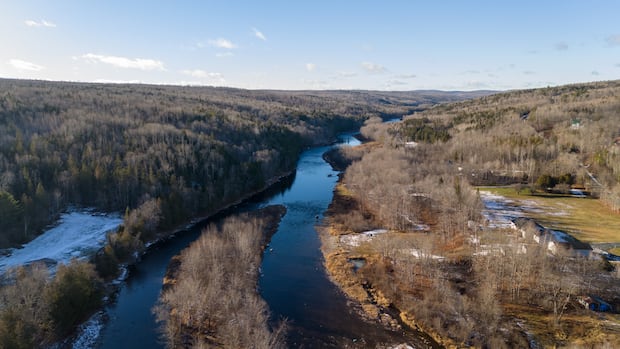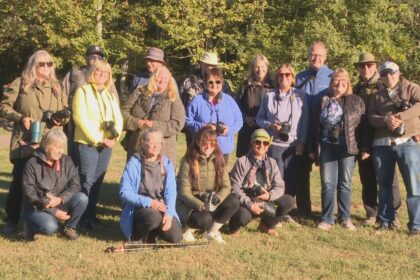New BrunswickEnvironmentalists are concerned that the conditions for approval of the Sisson Mine north of Fredericton were too weak when they were issued in 2015, and now many are a decade out of date.Opponents say decade-old environmental approval is outdated and should start overJacques Poitras · CBC News · Posted: Nov 25, 2025 5:00 AM EST | Last Updated: 1 hour agoListen to this articleEstimated 6 minutesThe audio version of this article is generated by text-to-speech, a technology based on artificial intelligence.Environmentalists are worried about the potential impact of the Sisson Mine project on the Naskwaak River watershed. (Roger Cosman/CBC)The New Brunswick government is acknowledging that none of the 40 conditions imposed on the Sisson Mine project have been met almost a decade after they were attached to the province’s environmental impact assessment approval. That is giving environmentalists another argument in their case against the massive resource project that would be built northwest of Fredericton.“The EIA process is a living process, so I’d say the 40 are not complied [with] yet, and we know that 28 of those conditions need to be fulfilled before construction starts,” Environment Minister Gilles LePage told reporters recently at the legislature. Critics say the conditions were too weak when they were issued in 2015, and now many are a decade out of date.“We don’t have a lot of faith that this project is going forward with high environmental standards,” said Allyson Heustis, the executive director of the Nashwaak Watershed Association.“It’s been about 15 years since they’ve been starting this proposed mine, so we’ve officially come out in opposition of the mine as it was proposed.” Allyson Heustis, the executive director of the Nashwaak Watershed Association, says many of the conditions for approval are weak or out of date. (Jacques Poitras/CBC)Among the 40 conditions are a water quality monitoring plan, air quality approval, modelling for potential tailings pond failures, an emergency response plan and a start of construction within five years.The province extended that deadline twice already, in 2020 and 2022.LePage extended it again earlier this month for another five years, until 2030.The mine would extract tungsten and molybdenum, two critical minerals used in energy applications like batteries, and also for military purposes.WATCH | ‘A hollow promise’: Mine opponents skeptical of provincial commitment:Sisson Mine hasn’t met any N.B. environmental conditionsWith Ottawa’s stamp of approval, mine debate shifts to meeting decade-old conditions — and whether to update them.The province estimated a decade ago it would generate $280 million in royalties for the government over the 27 years of operation.The federal government referred the mine to its Major Projects Office two weeks ago as part of an effort to weaken China’s domination of the global critical minerals market.Major project designation would allow for the fast-tracking of federal regulatory approvals, though even projects that are not designated can benefit from other forms of government support.The Susan Holt government is pushing for offtake agreements and a price floor — two measures that would guarantee sales of the mine’s minerals at a viable price.One reason the mine hasn’t advanced in the decade since its approval has been the low price of the minerals on the world market, which has made investors reluctant to back the project.Environmentalist Lawrence Wuest, a resident of Stanley, said moving ahead on some of the conditions — like financial guarantees on potential cleanup costs — “would be a feather in their cap to get private investment in the mine.“Why they haven’t done that — that’s a curious thing,” he said.Environmentalist and local resident Lawrence Wuest finds it curious Northcliffe Resources hasn’t moved on some of the conditions. (Mike Heenan/CBC News)The mine proponent Northcliff Resources said a decade ago the mine would operate for 27 years.Wuest said the fluctuation in mineral prices could force it to close sooner than that, creating a greater risk of leakage from the tailings pond into the Nashwaak River watershed.It could also leave the province absorbing those cleanup costs. “They want this mine there even if it’s economically unfeasible,” Wuest said.“They want it there as a kind of billboard to the rest of the world and the rest of Canada that New Brunswick is a place where mining can take place.” LePage told reporters that the 40 conditions will be tied to today’s environmental regulations, not the ones that were in effect a decade ago.“They’re still valid, but we have to make sure that they are up to date,” he said..“The standard of the response from the proponent has to be up to date with today’s regulations — municipal, provincial and federal.” Heustis said that among the changes since 2015 are new wetland mapping and further identification of species at risk in the watershed.But the critics also say the fundamental design of the project approved in 2015, including the tailings pond, is itself out of date and should require Northcliff to go back to the drawing board for a new EIA.“There’s been changes in best practices and best available technologies for this kind of an open pit mining operation with a low grade of ore,” Green Leader David Coon said.If developed the Sisson Mine would be in operation for about 27 years and cost an estimated $579 million. (Submitted by Sisson Mining Ltd.)Wuest called LePage’s commitment “a hollow promise” and said changes to best practices for tailings ponds and dams make the original approval irrelevant.“There should be a reset of that EIA,” he said.The 40 conditions are also key to First Nations acceptance of the project.Wolastoqey chiefs and the province signed an accommodation agreement for the mine in 2017, which Indigenous Affairs Minister Keith Chiasson said remains in effect.A spokesperson said none of the six chiefs would provide an interview for now.After the federal announcement earlier this month, they issued a statement saying they will “insist” that “the conditions upon which the mine was established will be maintained.”At the time of the 2015 EIA conditions, the province was not enforcing water classification regulations under the Clean Water Act.Those regulations, if applied to the Nashwaak, would have prohibited new sources of pollution in the watershed, Wuest said.He is pessimistic the province will restart the EIA process but says not doing so may add to the uncertainty for investors. “I would like to think that this thing is so bad that it could never generate enough investment to go ahead, but given the craziness that’s going on in the world, all bets are off,” Wuest said.Northcliff says it will make “a final investment decision … around 2027” with construction to follow if it’s approved.CEO Andrew Ing has not responded to multiple interview requests from CBC News.ABOUT THE AUTHORJacques Poitras has been CBC’s provincial affairs reporter in New Brunswick since 2000. He grew up in Moncton and covered Parliament in Ottawa for the New Brunswick Telegraph-Journal. He has reported on every New Brunswick election since 1995 and won awards from the Radio Television Digital News Association, the National Newspaper Awards and Amnesty International. He is also the author of five non-fiction books about New Brunswick politics and history.
None of 40 Sisson Mine conditions met so far, province says












